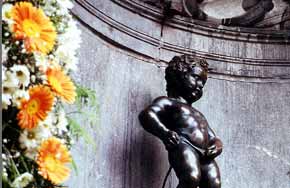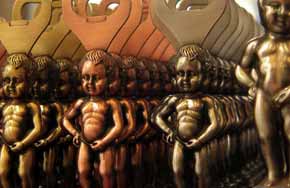Manneken Pis is an eminent Brussels landmark famous for its unique appearance. The Manneken-Pis is actually a small bronze fountain statue presenting a naked infant boy urinating into the basin of fountain. The statue was designed by Jerome Duquesnoy, a Baroque sculptor from Rome, who is specialized for portraying unbelievable emotions on his sketches. There seems to be a bit of confusion about the placement of the statue; it is believed to be put in place in the year 1618 or 1619. The statue endures a similar cultural importance as Copenhagen's Little Mermaid, created by Edvard Eriksen.
The famed sculpture is positioned at the joining point of Rue du Chêne/Eikstraat and Rue de l'Étuve/Stoofstraat. One is reachable to the sculpture by taking the left lane next from the renowned Grand Place to the Brussels Town Hall. After a small walk of about hundred meters from Grand Palace, one gets to view the sculpture. The sculpture has been repeatedly stolen several times; the current figure is an imitation from 1965. The real statue is safely kept at the Maison du Roi/Broodhuis on the Grand Place, the famed central square of Brussels.
There are many interesting tales attached to the statue; however, the most famed one is related to the Duke Godfrey III of Leuven. In the year, 1142, the soldiers of this two-year-old lord were fighting opposite the Berthouts, the lords of Grimbergen, in Ransbeke. The soldiers, who were saving the infant lord, hang him on a tree, after putting the lord into a basket, to encourage the enemies. From the tree, the infant lord urinated on the soldiers of an ancient knightly family, Berthouts, who finally lost the battle. The incident became one of the inspirations behind the Manneken-Pis Fountain.
The costume of the sculpture is frequently changed every week, according to a published timetable, which is placed on the railings around the Manneken-Pis fountain. His wardrobe comprises thousands of interesting attires, many of which may be witnessed in a permanent display within the City Museum, positioned in the Grand Place, just parallel to the Town Hall. The attires are managed by the nonprofit organization called The Friends of Manneken-Pis that analyze hundreds of designs presented each year, and later choose a small number of costumes to be made and used.
However, the proliferation of attires is a twentieth-century origin, but the episodic use of attires dates back to the seventeenth-century. The changing of the costume is a vibrant and beautiful ceremony, frequently accompanied by enchanting brass band music. It’s a never-miss occasion, viewed by almost all the locals.







